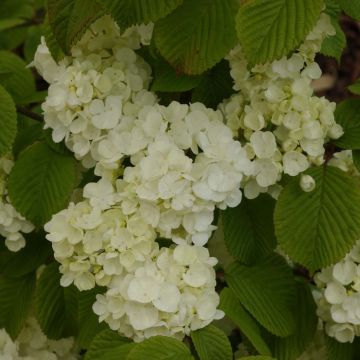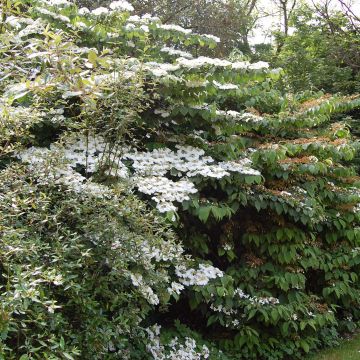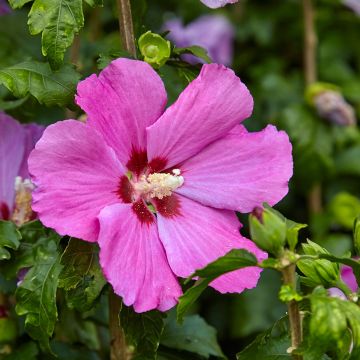

Viburnum farreri
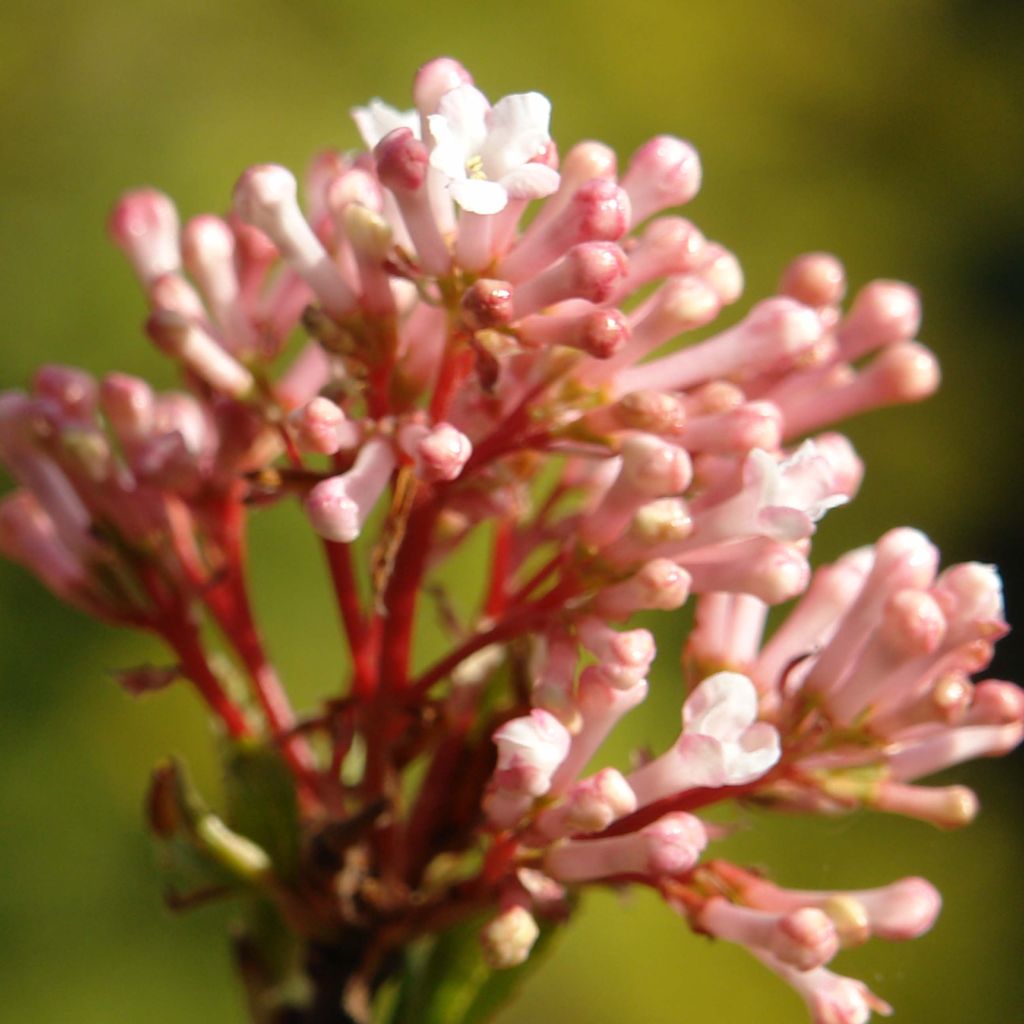

Viburnum farreri
Viburnum farreri
Viburnum farreri
Farrer's viburnum, fragrant viburnum
True to the photo, the packaging was perfect, and the plant was very well protected. It is now in the garden growing, and we will wait until next winter to see it bloom.
Annick, 24/02/2024
Special offer!
Receive a €20 voucher for any order over €90 (excluding delivery costs, credit notes, and plastic-free options)!
1- Add your favorite plants to your cart.
2- Once you have reached €90, confirm your order (you can even choose the delivery date!).
3- As soon as your order is shipped, you will receive an email containing your voucher code, valid for 3 months (90 days).
Your voucher is unique and can only be used once, for any order with a minimum value of €20, excluding delivery costs.
Can be combined with other current offers, non-divisible and non-refundable.
Home or relay delivery (depending on size and destination)
Schedule delivery date,
and select date in basket
This plant carries a 24 months recovery warranty
More information
We guarantee the quality of our plants for a full growing cycle, and will replace at our expense any plant that fails to recover under normal climatic and planting conditions.


Would this plant suit my garden?
Set up your Plantfit profile →
Description
Viburnum farreri (synonym fragrans) is one of the parents of Viburnum bodnantense, to which it bears a strong resemblance. However, it differs by having a more open habit, a more pronounced tendency to sucker, and a longer and more discreet winter flowering that is slightly less fragrant. The small clusters of white-pink flowers appear from November onwards and continue to bloom until March, with successive waves during mild spells. Another asset of this bush is its beautiful bronze foliage in spring, which turns green and more inconspicuous in summer before displaying stunning autumn colours. Charming and undemanding, this viburnum is easily grown in most regions, provided that proper care is taken at planting.
Viburnum farreri is a deciduous shrub from the caprifoliaceae family (now adoxaceae), characterized by a long and pleasantly fragrant autumn and winter flowering that appears on its bare and slightly arching branches. It is native to the mountainous regions of western China, where it was discovered in 1910 by Reginald Farrer. It is a robust plant, well adapted to mountain climates and tolerant of well-drained, slightly alkaline soils that are not too dry.
It has an upright, open habit with few branches, and it spreads by sucker formation at the edge of the stump. Its growth rate is moderate. At maturity, the bush will reach a height of about 3m (10ft) with a spread of 2.5m. The flowering starts in November and continues sporadically until March, during mild spells. The flowers appear at the ends of the reddish-brown branches and also in the axils of the buds. The 5-7cm (2-3in) inflorescences consist of bright pink flower buds that open into almost white tubular flowers with a delightful fragrance. The colour of the buds becomes more pronounced in March. The foliage of Farrer's viburnum is copper-bronze when it first emerges, gradually turning bright green in summer. The brilliant autumn colours are various shades of red and purple. The leaves are ovate, deeply toothed, with prominent veins, and measure 10cm (4in) in length. It will occasionally produce small red fruits.
This viburnum can be planted in borders, informal or flowering hedges, or as a solitary specimen, preferably near the house or a pathway to fully enjoy the fragrance and delicate beauty of the flowers in the middle of winter. To accompany it, plant some hyacinth or winter aconite bulbs at its base, and consider planting a Sarcococca, Garrya elliptica, or witch hazel (in less alkaline soil) nearby. Contrary to popular belief, Viburnum farreri adapts well to various soils and climates, including mountainous or Mediterranean regions, as long as it has sufficiently deep soil to draw moisture from in dry summers. Cut the flowers to create beautiful bouquets. Viburnums are easy-to-grow shrubs and by mixing different species together or by combining them with other flowering shrubs, you can create a charming and ever-changing garden throughout the year.
Report an error about the product description
Viburnum farreri in pictures
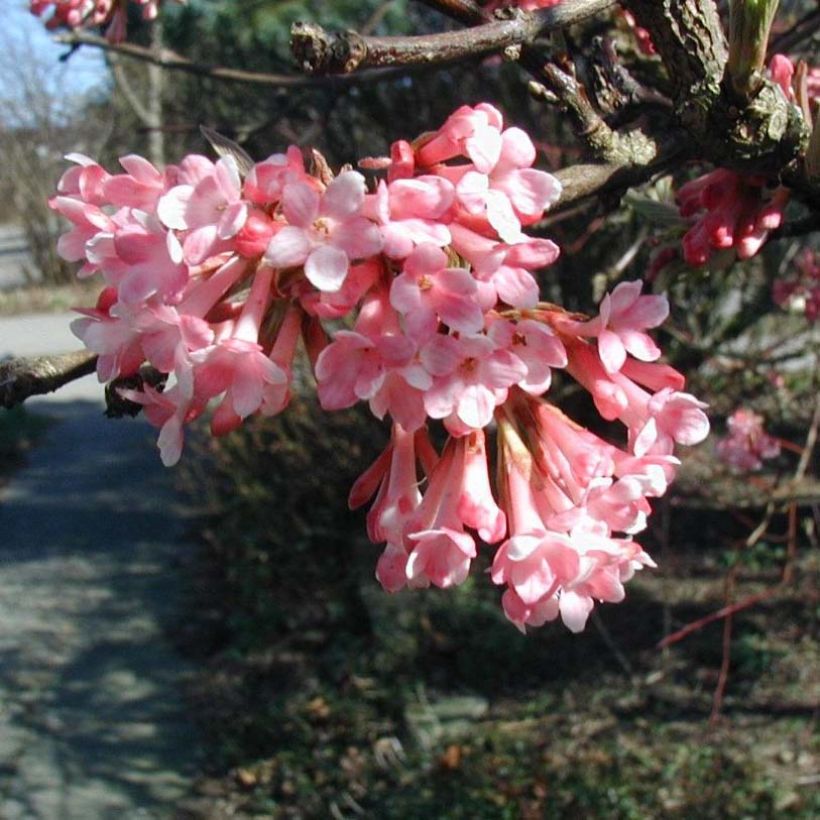

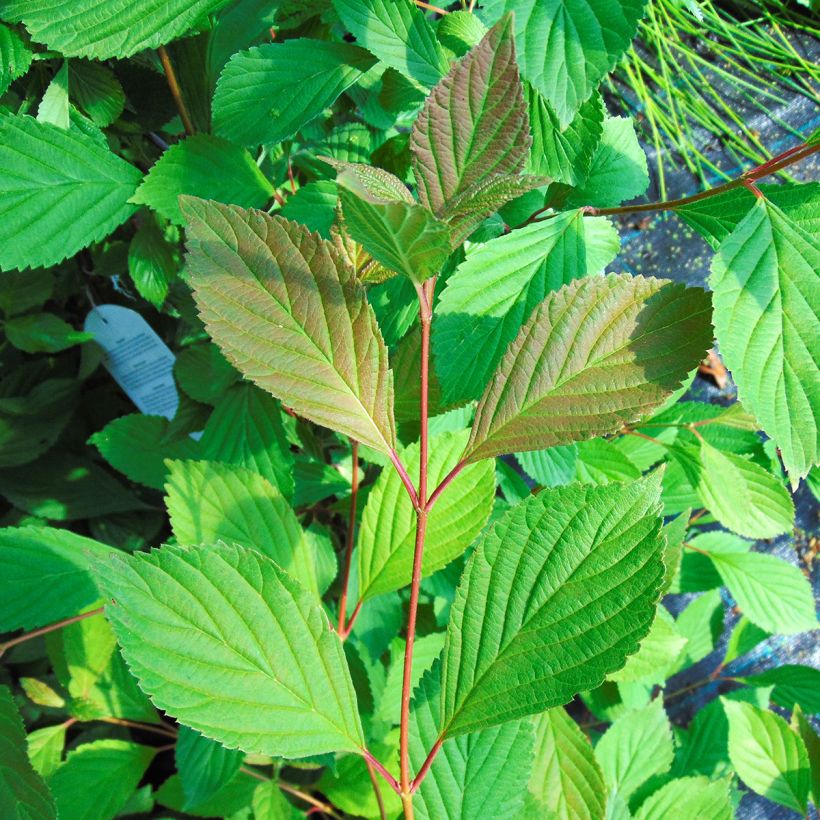

Plant habit
Flowering
Foliage
Botanical data
Viburnum
farreri
Caprifoliaceae (Adoxaceae)
Farrer's viburnum, fragrant viburnum
China
Other Viburnum
View all →Planting and care
Viburnum farreri is best planted in autumn or early spring, outside of freezing periods. It can be grown in full sun or partial shade, sheltered from cold and drying winds that could spoil its flowering. Place it in any type of deep soil, not too dry, preferably enriched with compost at planting. Water to help the plant establish itself, especially during the first two or three summers depending on the region. This easy-to-grow bush requires little maintenance. Viburnum is often attacked by aphids without much damage. After flowering, you can prune the bush if you want to densify its habit. Trim lightly and remove branches that compromise the plant's symmetry. Viburnum farreri tolerates severe pruning.
Planting period
Intended location
Care
-
, onOrder confirmed
Reply from on Promesse de fleurs
Similar products
Haven't found what you were looking for?
Hardiness is the lowest winter temperature a plant can endure without suffering serious damage or even dying. However, hardiness is affected by location (a sheltered area, such as a patio), protection (winter cover) and soil type (hardiness is improved by well-drained soil).

Photo Sharing Terms & Conditions
In order to encourage gardeners to interact and share their experiences, Promesse de fleurs offers various media enabling content to be uploaded onto its Site - in particular via the ‘Photo sharing’ module.
The User agrees to refrain from:
- Posting any content that is illegal, prejudicial, insulting, racist, inciteful to hatred, revisionist, contrary to public decency, that infringes on privacy or on the privacy rights of third parties, in particular the publicity rights of persons and goods, intellectual property rights, or the right to privacy.
- Submitting content on behalf of a third party;
- Impersonate the identity of a third party and/or publish any personal information about a third party;
In general, the User undertakes to refrain from any unethical behaviour.
All Content (in particular text, comments, files, images, photos, videos, creative works, etc.), which may be subject to property or intellectual property rights, image or other private rights, shall remain the property of the User, subject to the limited rights granted by the terms of the licence granted by Promesse de fleurs as stated below. Users are at liberty to publish or not to publish such Content on the Site, notably via the ‘Photo Sharing’ facility, and accept that this Content shall be made public and freely accessible, notably on the Internet.
Users further acknowledge, undertake to have ,and guarantee that they hold all necessary rights and permissions to publish such material on the Site, in particular with regard to the legislation in force pertaining to any privacy, property, intellectual property, image, or contractual rights, or rights of any other nature. By publishing such Content on the Site, Users acknowledge accepting full liability as publishers of the Content within the meaning of the law, and grant Promesse de fleurs, free of charge, an inclusive, worldwide licence for the said Content for the entire duration of its publication, including all reproduction, representation, up/downloading, displaying, performing, transmission, and storage rights.
Users also grant permission for their name to be linked to the Content and accept that this link may not always be made available.
By engaging in posting material, Users consent to their Content becoming automatically accessible on the Internet, in particular on other sites and/or blogs and/or web pages of the Promesse de fleurs site, including in particular social pages and the Promesse de fleurs catalogue.
Users may secure the removal of entrusted content free of charge by issuing a simple request via our contact form.
The flowering period indicated on our website applies to countries and regions located in USDA zone 8 (France, the United Kingdom, Ireland, the Netherlands, etc.)
It will vary according to where you live:
- In zones 9 to 10 (Italy, Spain, Greece, etc.), flowering will occur about 2 to 4 weeks earlier.
- In zones 6 to 7 (Germany, Poland, Slovenia, and lower mountainous regions), flowering will be delayed by 2 to 3 weeks.
- In zone 5 (Central Europe, Scandinavia), blooming will be delayed by 3 to 5 weeks.
In temperate climates, pruning of spring-flowering shrubs (forsythia, spireas, etc.) should be done just after flowering.
Pruning of summer-flowering shrubs (Indian Lilac, Perovskia, etc.) can be done in winter or spring.
In cold regions as well as with frost-sensitive plants, avoid pruning too early when severe frosts may still occur.
The planting period indicated on our website applies to countries and regions located in USDA zone 8 (France, United Kingdom, Ireland, Netherlands).
It will vary according to where you live:
- In Mediterranean zones (Marseille, Madrid, Milan, etc.), autumn and winter are the best planting periods.
- In continental zones (Strasbourg, Munich, Vienna, etc.), delay planting by 2 to 3 weeks in spring and bring it forward by 2 to 4 weeks in autumn.
- In mountainous regions (the Alps, Pyrenees, Carpathians, etc.), it is best to plant in late spring (May-June) or late summer (August-September).
The harvesting period indicated on our website applies to countries and regions in USDA zone 8 (France, England, Ireland, the Netherlands).
In colder areas (Scandinavia, Poland, Austria...) fruit and vegetable harvests are likely to be delayed by 3-4 weeks.
In warmer areas (Italy, Spain, Greece, etc.), harvesting will probably take place earlier, depending on weather conditions.
The sowing periods indicated on our website apply to countries and regions within USDA Zone 8 (France, UK, Ireland, Netherlands).
In colder areas (Scandinavia, Poland, Austria...), delay any outdoor sowing by 3-4 weeks, or sow under glass.
In warmer climes (Italy, Spain, Greece, etc.), bring outdoor sowing forward by a few weeks.































